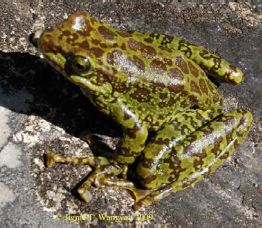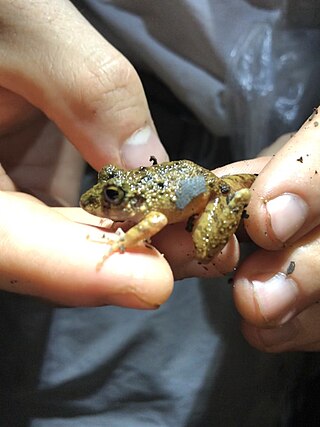
Oreobates is a genus of frogs in the family Strabomantidae. Most species were formerly in the genus Ischnocnema, but were moved to this revalidated genus following a 2006 revision. Its sister taxon is Lynchius.
The Pilalo tree frog is a species of frog in the family Hylidae endemic to Ecuador. Its natural habitats are subtropical or tropical moist montane forests and rivers. It has been observed between 2300 and 2600 meters above sea level. It is threatened by habitat loss.
The Chinamococh stream frog is a species of frog in the family Hylidae endemic to Guatemala. Its natural habitats are subtropical or tropical moist lowland forests and rivers. It is threatened by habitat loss.
Oreobates cruralis, also known as the La Paz robber frog, is a species of frog in the family Strabomantidae. It is found in Bolivia, Peru, and possibly Brazil. Its natural habitats are subtropical or tropical moist lowland forest, subtropical or tropical moist montane forest, plantations, rural gardens, and heavily degraded former forest.
Oreobates discoidalis, also known as the Tucuman robber frog, is a species of frog in the family Strabomantidae. It is found on the eastern flanks of the Andes in northern Argentina and Bolivia. Its natural habitat is subtropical or tropical moist montane forest. It is threatened by habitat loss.
Oreobates ibischi is a species of frog in the family Strabomantidae. It is endemic to Bolivia. Its natural habitats are subtropical or tropical dry forest, rural gardens, and heavily degraded former forest. It is threatened by habitat loss.
Oreobates lundbergi is a species of frogs in the family Strabomantidae. It is endemic to central Peru and is known from the Amazonian slopes of the Cordillera Oriental in the Paucartambo District, Pasco.
Oreobates madidi is a species of frog in the family Strabomantidae. It is endemic to Bolivia. Its natural habitat is subtropical or tropical moist montane forest.
Oreobates zongoensis is a species of frog in the family Strabomantidae. It is endemic to Bolivia from Zongo Valley, in Pedro Domingo Murillo Province.
Oreobates choristolemma is a species of frog in the family Strabomantidae. It is endemic to Bolivia where it is known from its type locality, Serranía de Bella Vista in the Caranavi Province as well as from Sud Yungas Province and from Chapare Province in the Cochabamba Department.

Oreobates quixensis, also known as the common big-headed frog, is a species of frog in the family Strabomantidae. It is found in the upper Amazon Basin in Bolivia, western Brazil, Colombia, Ecuador, and Peru. It is a very common terrestrial frog of primary and secondary tropical moist forest, also to be found in clearings, open areas and banana groves.
Oreobates sanderi is a species of frog in the family Strabomantidae. It is found in north-western Bolivia and nearby south-eastern Peru. It is not considered threatened by the IUCN.
Oreobates saxatilis, also known as Tarapoto big-headed frog, is a species of frog in the family Strabomantidae. It is endemic to Peru and known from near its type locality near Tarapoto as well as from the Río Tambo District in the Satipo Province, Panguana in the Puerto Inca Province, and Río Kimbiri in the La Convención Province.
Lynchius simmonsi, also known as Simmons' big-headed frog, is a frog species in the family Strabomantidae. It is endemic to southern Ecuador where it is known from the type locality in the Cordillera del Cóndor, Morona-Santiago Province as well as from the adjacent Zamora-Chinchipe Province. Its natural habitat is subtropical old-growth forest. The type series was collected by day on the forest floor. The area was mined during the Cenepa War in 1995, and has consequently seen little human activity, although this may change through a proposed road.
Oreobates pereger, also known as the Ayacucho Andes frog, is a species of frog in the family Strabomantidae. It is endemic to Peru where it is known from the eastern slopes of the Cordillera Oriental and Cordillera Vilcabamba mountain ranges.

Amolops mantzorum, commonly known as the Sichuan torrent frog or Kangting sucker frog, is a species of frog in the family Ranidae. It is found in Gansu, Sichuan, and Yunnan Provinces of China. It has recently been reported also from Bhutan.
Amolops tuberodepressus is a species of frog in the family Ranidae. It is endemic to Yunnan, China and known from Wuliang and Ailao Mountains in Jingdong County. Once suspected to be synonym of Amolops mantzorum, its validity was confirmed with molecular methods in 2014.
Cornufer schmidti is a species of frog in the family Ceratobatrachidae. It was first described as a subspecies of Platymantis papuensis. It is the type species of the subgenus Aenigmanura within Cornufer. It is endemic to the Bismarck Archipelago, Papua New Guinea, and is known from the islands of New Britain, New Ireland, and Manus; the Manus population might represent a distinct species.
Oreobates ayacucho is a species of frogs in the family Strabomantidae. It is endemic to Peru and known from a few localities in the Ayacucho Region in the Peruvian Andes. The species is only known from 11 specimens.

Oreobates amarakaeri, also known as Amarakaeri's big-headed frog is a species of frog in the family Strabomantidae, which is endemic to a small region of south-eastern Peru, in the Manú District, and parts of the Puno Region. The frog was first discovered near the Rio Nusinuscato and Rio Mabe rivers in the Andean foothills of the Amarakaeri Communal Reserve, which are tributaries of the Rio Araza. Since then the species has also been found at the Manú Learning Centre and near Bahuaja Sonene National Park, but weren't fully confirmed to be there until 2019 when four specimens were collected at those localities. At the Manú Learning Centre the frog is known to occur mainly in low disturbance and primary forest habitat, but can also be found near streams in more disturbed areas.



